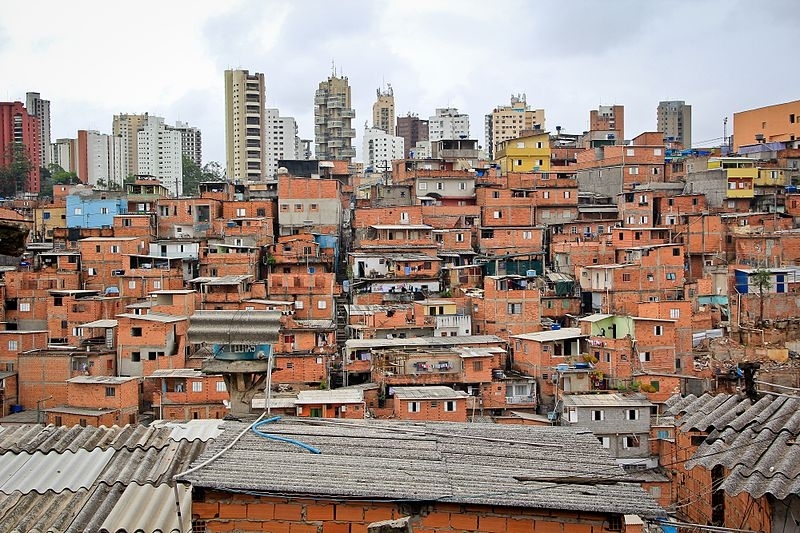


Study shows that São Paulo City has eight distinct urban groups in economic, social and cultural terms, making effective action against the pandemic a challenge (photo: Paraisópolis, a favela in the south of São Paulo City / Vilar Rodrigo / Wikimedia Commons)
Published on 03/23/2021
By José Tadeu Arantes | Agência FAPESP – In a complex mega-city, such as São Paulo (Brazil), with great economic, social and cultural inequality, designing strategies for effective action to combat COVID-19 is a daunting challenge.
The differences among social groups in a city with more than 12 million inhabitants are evidenced by the study “Os padrões urbano-demográficos da capital paulista” (“Urban-demographic patterns in São Paulo City”), as reported in an article by Marcelo Nery, Altay de Souza and Sérgio Adorno.
The study was supported by FAPESP and conducted under the aegis of the University of São Paulo’s Center for Research on Violence (NEV-USP), one of the Research, Innovation and Dissemination Centers (RIDCs) funded by FAPESP.
“Combating the pandemic in São Paulo is extremely challenging because the city is so heterogeneous,” Adorno told Agência FAPESP. “It isn’t just split between center and periphery, or between rich and poor. The situation is far more complex than that.” Adorno is NEV-USP’s scientific coordinator and a professor in the university’s School of Philosophy, Letters and Human Sciences (FFLCH-USP).
Adorno pointed out the large proportion of the population living in precarious dwellings as an example (read more at: agencia.fapesp.br/32950). “Necessary though it is, compliance with social isolation or confinement orders is much harder in urban areas mainly inhabited by low-income workers with little schooling, in multifamily units with many people per room,” he said. “Furthermore, most people in these areas spend the day in activities away from home, which intensifies interpersonal contact. Large numbers of informal workers have to go out into the street every day to make a living. The pandemic dramatically highlights Brazil’s scandalous social inequality.”
Distinct urban groups
The article by Adorno and collaborators is part of a large-scale longitudinal survey that began in 2013. Longitudinal studies involve repeated observation of the same variables and groups of people over long periods.
The researchers identified eight urban groups that differ strongly from each other and have been constituted throughout the history of the city’s expansion. “They’re not defined solely in spatial terms but based on 19 economic, social and cultural variables submitted to factor analysis,” Adorno said.
To map this mosaic, the researchers used housing, population, public health and sanitation data from the last four censuses conducted by IBGE, the national census and statistics bureau (1980, 1991, 2000 and 2010), in conjunction with a 2007 São Paulo subway origin-destination survey and information from the municipal government and EMPLASA, the metropolitan planning board. They compiled 19 indicators relating to the environment, housing and basic sanitation, as well as urban mobility and crime, among other factors.
Based on an analysis of these indicators, they divided São Paulo City into eight groups. Group A inhabits the city center, an area that includes Avenida Paulista and Avenida Engenheiro Luís Carlos Berrini, for example, and enjoys good sanitation, the highest frequency of permanent private homes, and the highest number of multistory buildings. It also has high proportions of literate heads of household (99.3%) and high-income families (8.6%), with no violent crime or fatal shootings in several sectors.
Group B also lives in the center, with the same good sanitation and a similar proportion of permanent private homes, but a higher proportion of improvised dwellings, low population density and more young male inhabitants.
With a small proportion of subnormal irregular dwellings and good sanitation, Group C also has mostly literate heads of household (98.9%) but fewer high-income families (5.5%). In the case of Group D, the main features are few multistory buildings, a low proportion of homes with basic sanitation, and less adequate infrastructure than the first three groups.
Group E is characterized by overcrowded or improvised housing (25.5%) and even fewer high-income families, with many migrants moving into the area and a growing demand for housing since the 1950s. Traffic is excessive, and there are many tenements and favelas.
Group F inhabits water source protection and high-risk areas on the outskirts of the city, with low relative growth in the population and the number of permanent private dwellings.
Group G is the result of disorderly urbanization and expansion of favelas and is considered particularly vulnerable owing to lack of housing security and the poor quality of public services. Group H lives in high-risk areas on the fringes of Serra da Cantareira, a protected Atlantic Rainforest fragment in the far north of the municipality, and has the worst sanitation and violent crime rates.
“The study clearly shows that the urban space is heterogeneous,” the authors say, stressing that the center-periphery dichotomy alone is not capable of explaining the city’s social, economic and land-use diversity.
They conclude that the “identification of these urban patterns points to a research and intervention strategy” and that the patterns “can form the basis for a public administration with a better fit to the structure of the municipality and, hence, better able to implement more effective and suitably grounded policies”.
According to Adorno, “the state is lagging behind in terms of social dynamics. Even in São Paulo, the most developed city in Brazil, the politico-administrative divisions don’t correspond to the real city. Some people benefit to the detriment of others”.
Source: https://agencia.fapesp.br/33379